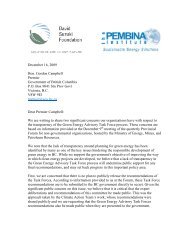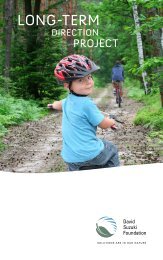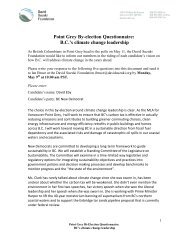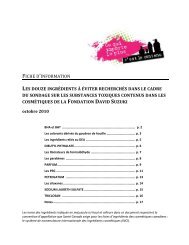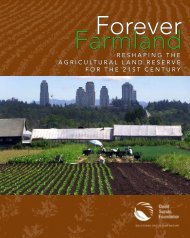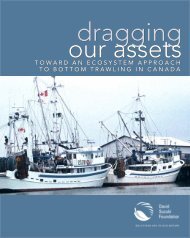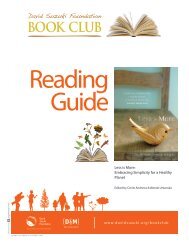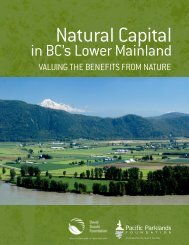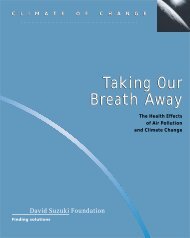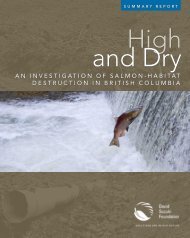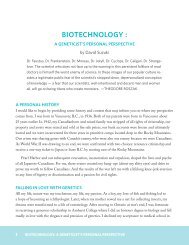findingSOLUTIONSapr2013.pdf - David Suzuki Foundation
findingSOLUTIONSapr2013.pdf - David Suzuki Foundation
findingSOLUTIONSapr2013.pdf - David Suzuki Foundation
- No tags were found...
You also want an ePaper? Increase the reach of your titles
YUMPU automatically turns print PDFs into web optimized ePapers that Google loves.
findingSOLUTIONSspring 2013www.davidsuzuki.orgYour right to a healthy environmentAbout 10 years ago, public health worker Beatriz Mendoza moved toa heavily industrialized and polluted neighbourhood in Buenos Aires.When her health began to suffer, she hired a lawyer and sued the federal,provincial and municipal governments, as well as 44 companies,for violating her constitutional right to a healthy environment.The case eventually reached the Supreme Court, which decidedthat Mendoza’s right had been violated. The court ordered all levelsof government to clean up the watershed, build infrastructurefor drinking water and sewage treatment, implement environmentalmonitoring and address citizens’ health problems. Since then,remarkable progress has been made in the area.Though this victory took place in Argentina, it could wellhave played out in any of nearly 100 countries worldwide.Unfortunately, it couldn’t have happened in Canada. OurConstitution does not recognize the right to a healthy environment.That’s why the <strong>David</strong> <strong>Suzuki</strong> <strong>Foundation</strong> has partnered withEcojustice and renowned environmental lawyer <strong>David</strong> Boydto ensure all Canadians get legal protection for their right toa healthy environment. We believe everyone needs access toclean air, safe water, fertile soil and nutritious food to surviveand thrive.In February, we held a telephone town hall, giving our supportersan opportunity to ask Boyd and our CEO Peter Robinsonabout the global environmental rights movement and our journeytoward constitutional reform.The response was overwhelming; we received far more questionsthan could be answered at the town hall. So on page 3,you’ll find answers to some of the most asked. You’ll also find thepetition we are encouraging Canadians to sign, to pledge theirsupport for this crucial constitutional reform.We hope you’ll join us on this challenging and exciting journey.Find out more at davidsuzuki.org/right-to-healthy-environment.The <strong>David</strong> <strong>Suzuki</strong> <strong>Foundation</strong> teamPHOTO: DREW BRAWSHAW VIA FLICKRThanks to you, we’re fighting for Canadians’ rights to live in a healthy environmentOntario’s EndangeredSpecies ActCanada’s 30 x 30Catwalk with aA new development4 5 6 8Nature Challengeconscienceparadigm
donor profileDonor inspires by exampleDonor Kelly Godin sports her favouriteT-shirt at Soupstock last SeptemberI’d much rather spend a littleextra to ensure my food isgrown locally instead of, say,buying a new pair of shoes.After all, you can’t eat shoes.<strong>Foundation</strong> donor Kelly Godin lives inMississauga, Ontario. When she’s notworking as an office administrator, shecan be found tending the big garden patchthat feeds her family throughout the year.She also loves baking, bike-riding andwalking the shores of Lake Ontario.Why did you decide to donateto the <strong>Foundation</strong> ?I grew up watching <strong>David</strong> <strong>Suzuki</strong> onThe Nature of Things, and he has alwaysinspired me to learn about nature andecosystems. He helped me realize howhumans have impacted the natural balancethat existed on Earth for millions ofyears. The Earth is a priority for me, as itprovides everything we need. The moneyI donate to the <strong>Foundation</strong> helps protectwhat matters to me most: our home.How does your lifestyle reflectyour care for the environment?I try to do everything I can to reduce mycarbon footprint. Every small step counts;it’s about making conscientious changes inmy daily life. I invested in energy-efficientappliances, furnace and light bulbs. Mywindows are covered in plastic for extrainsulation in the winter, saving electricity.We have low-flow toilets and showerheads.I compost and recycle and take publictransit. I make my own natural householdcleaners. And I love talking to people aboutviable solutions for a sustainable planet.Tell us about your experienceat Soupstock this past year.Soupstock was an amazing experience.There was so much positive energy amongthousands of like-minded people enjoyingdelicious food produced from our Ontariofarmlands. It was a great success, as wewere able to stop the mega-quarry andsave over 900 hectares of rich, fertilefarmland. It was very empowering.Which environmental issueconcerns you the most, andwhat are you doing about it?I’m very concerned about our future foodand water supply, so my goal is to build aself-sustaining greenhouse in my backyardwhere I can grow food year-round. Inthe meantime, I shop almost exclusively atfarmers markets in the warmer months. Ilove interacting with the people who dedicatetheir lives to providing us sustenance.I’d much rather spend a little extra toensure my food is grown locally instead of,say, buying a new pair of shoes. After all,you can’t eat shoes.Leave a legacy for thechildren of tomorrowBuild the <strong>David</strong> <strong>Suzuki</strong> <strong>Foundation</strong> into your estateplanning. Consider a gift in your will, or another typeof legacy gift, to help ensure a healthy environment forgenerations to come. Or, if you’ve already done so, let usknow so we can thank you!Please contact Katie Loftus at604.732.4228 • kloftus@davidsuzuki.org2
We, the people of Canada, believe:Clean air, water and land keep us healthyand are a human right we’re all entitled to;Canada’s many plants and animals and ournatural heritage should be protected for thebenefit of everyone, now and into the future;The beauty and diversity of nature are atthe heart of what it means to be Canadian;Canada should stand with more than100 countries where the right to ahealthy environment is recognized inlaw —including the constitution.We therefore ask that:1. The right to a healthy environmentbe incorporated into the CanadianCharter of Rights and Freedoms;2. All levels of government enact or strengthenlegislation recognizing and protectingthe right to a healthy environment.Frequently asked questions about your rightto a healthy environmentPHOTO: STEVE.JACKSON VIA FLICKRSupporters like you have asked some excellent questions about ourgoal of achieving the constitutional right to a healthy environmentin Canada. Here are <strong>David</strong> Boyd’s answers to a few of the most frequentlyasked questions.1. What difference would it make if Canadianshad the right to a healthy environment?A constitutional right to live in a healthy environment would havea transformative effect. Canadians would have a greater role inmaking decisions that affect the environment, our health and ourcommunities. If governments and industries failed to respect ourright to a healthy environment, we could hold them accountable.Over time, we would breathe cleaner air, drink safer water, beexposed to fewer toxic chemicals and enjoy healthier ecosystems.If our Constitution included the right to a healthy environment,there is no way our national rules would allow five timesthe level of sulphur dioxide in our air than is permitted underAmerican rules. Canada would also have to revisit the approvalof hundreds of pesticides no longer used in Europe because ofhealth and environmental concerns.2. Do countries with the right to a healthy environmentactually have healthier environments and people?In general, these countries have smaller ecological footprints, rankhigher on comparisons of environmental performance and have donea better job of addressing issues such as air pollution and climatechange than countries whose constitutions lack this right. If youlook at the environmental records of countries in the Organizationfor Economic Cooperation and Development, which includes mostof the world’s wealthy industrialized nations, you find 14 of the top15 nations have constitutional provisions mandating environmentalprotection. Six of the seven countries with the worst environmentalrecords lack constitutional protection for the environment.3. Can we also tackle environmental rights atprovincial, territorial and municipal levels? How?Canadians should demand that their provincial, territorial andmunicipal governments enact environmental bills of rightsor strengthen existing laws. Quebec is a leader in this regard,recognizing the right to a healthy environment in both itsEnvironmental Quality Act and its Charter of Human Rights andFreedoms. Ontario, the Yukon, the Northwest Territories andNunavut also have laws recognizing this right, but these laws areweak and do not give citizens the tools needed to protect theirrights. Montreal recently became the first Canadian city to recognizeenvironmental rights and responsibilities.Do you think Canadians deserve the right toa healthy environment? Sign our petition atdavidsuzuki.org. We’ll keep you informedof our actions and how you can get involvedin the journey toward this importantconstitutional amendment.3
iefsA voice for whales in courtOur marine life knows no borders, so the <strong>Foundation</strong> andthree other Canadian environmental groups, represented byEcojustice lawyers, have joined a U.S. court case to speak forwhales affected by U.S. Navy training practices. The highintensitynoise from sonar not only disrupts mating, feedingand nursing behaviours for marine creatures, but also injuresand kills whales we are working to protect.Ontario exempts industryfrom species actMore than 5,000 <strong>Foundation</strong> supporters spoke up in Januaryon behalf of more than 200 of Ontario’s most threatened species.They submitted comments to the Ministry of NaturalResources about its vague proposal to exempt industry fromthe provincial Endangered Species Act. Because of this overwhelmingresponse, the government has provided more clarityon its proposal. Unfortunately, it confirmed intentions toexempt mining, logging and energy companies from complyingwith the Act. With your support, we will continue to advocatethat industry not get a free ride.The barn owl is one of Ontario’s threatened species in need of astrong Endangered Species Act.Fighting climate change whilecelebrating winterThe 2013 Winter Summit was another huge success!Presented by Desjardins Group and held in Quebec City fromJanuary 31 to February 3, this year’s Summit focused on findingsolutions to fight climate change while celebrating winter.Hundreds of people gathered for a panel discussion on citizenengagement, a roundtable with experts on climate change andour classic outdoor hockey game with NHL alumni and celebs.The Trottier team is envisioning an 80 per cent reduction inCanada’s greenhouse gas emissions.PHOTO: STEVEN VANCE VIA FLICKRResearch shows 80per cent greenhousegas reduction is doableTwo new research reports by the Trottier Energy FuturesProject (TEFP), a partnership between the <strong>Foundation</strong>, theCanadian Academy of Engineering and the Trottier Family<strong>Foundation</strong>, show that it’s realistic for Canada to cut itsenergy-related greenhouse gas emissions 80 per cent by 2050.Eighty per cent is a key milestone, the minimum targetfor industrialized countries to avoid the worst effects ofclimate change.One report, titled Low-Carbon Energy Futures: A Review ofNational Scenarios, looked at common features in greenhousegas-reduction scenarios for eight countries, including Canada.It concluded that the 80 per cent target would be doable andtransformative, requiring a clean-energy boom on a par withthe increase in fossil fuel consumption that followed theSecond World War.The second report, An Inventory of Low-Carbon Energy forCanada, found that Canada has a large enough supply of carbon-freeenergy to meet the 80 per cent target. The challengewill be to integrate those sources in an affordable and resilientnew energy supply system.“With this research in hand, we can make the case that alow-carbon future is possible, and that it’s actually a prosperousfuture,” says managing director Ralph Torrie. The team isproducing a set of detailed scenarios that will allow Canadiansto envision such a low-carbon energy future.Download the new reports at trottierenergyfutures.ca.Mitchell BeerDeputy director, Trottier Energy Futures Project4
Join Canada’s 30 x 30Nature ChallengeWant to get healthier, happier and smarter, just by spending timein the places you love most? This May, join our 30 x 30 NatureChallenge! For the second year, we’ll be helping Canadians getoutside in nature for 30 minutes a day for 30 days.Countless studies show that being regularly immersed in a naturalsetting, like a park, ravine or forest, can lower blood pressure,anxiety and stress levels and boost immunity. “Green time” alsoreduces feelings of anger and depression, while increasing energy,creativity and even generosity.Sign up for the challenge at davidsuzuki.org/30x30challenge.Throughout May, you’ll receive helpful tips and inspiring stories, aswell as opportunities to win great prizes.How can you add a daily dose of nature? Eat lunch in a nearbypark, take your meetings outside or skip the gym and take a jogor walk outside. We at the <strong>Foundation</strong> will embrace the challengealongside you.Jode RobertsIt’s true! Playing in the mud will make you smarter and healthier!PHOTO: JODE ROBERTSVictories you made happen last yearThe past year was a challenging one for us at the <strong>Foundation</strong> andsupporters like you who uphold the quintessentially Canadianvalues of democracy and environmental protection. The federalgovernment called us and other environmental organizations“radical” and “un-Canadian” for standing up for nature. Theyrammed through omnibus budget bills and erased long-heldenvironmental protections.But with your support, we pushed back, showing that we wouldnot be deterred from inspiring Canadians to act with nature in mind.Together, we proved that people power still prevails.Our annual report is now live online. In it, you’ll find these inspiringstories and many more:• Inspiring Ontarians to put food and water first• Protecting Canadians’ from asbestos• Motivating families to get back outside• Creating a path to a low-carbon futureFind these stories, plus an infographic, messages from our leadersand information about our funders and financials at davidsuzuki.org/2012-annual-reportRachelle Delaney5
funding solutionsCatwalk with a conscienceMany Canadian cities promote events with giant nylon bannershung from lampposts. Often, these banners end up in the locallandfill. But in 2008, Simon Fraser University students beganteaming up with B.C. Lower Mainland high school students totransform the banners into reusable bags.This year, SFU took the initiative a step further, joining forceswith Kwantlen Polytechnic University’s John Casablancas Instituteto help aspiring young designers turn the banners into coats,dresses and purses for the Beyond the Bag Eco-Fashion Showcase.Half the proceeds from ticket sales were donated to the <strong>David</strong><strong>Suzuki</strong> <strong>Foundation</strong>.Repurposing banner fabric keeps hundreds of kilograms ofnylon out of landfills, saves manufacturers and cities thousandsin disposal costs and teaches sustainability principles to buddingbusiness owners. In addition to banner nylon, participantswere allowed to use only recyclable materials for decorationand assembly.Senior (Grade 12) winner Olivia Bickerstaff scored an internshipwith guest judge Katherine Soucie, CEO of Sans Soucie, azero-waste company that makes clothing from textile industrialwaste. Grade 11 student Erin Wong won the junior prize—shadowingSoucie for a day. Tovah Paglaro, <strong>David</strong> <strong>Suzuki</strong>’s Queenof Green, and Shannon Oehlschlager, engineering technicianSenior winner Olivia Bickerstaff (left) and senior runner-up SharonChuang show off their recycled creations.at Vancouver-based Arc’teryx Equipment Inc. and co-founder ofArtemis Design Collective, were also judges.SFU mentors are all members of Enactus, a global organizationencouraging entrepreneurship that emphasizes social, environmentaland economic needs.Gail Mainstergreen livingCompanion plantingfor a healthy gardenCompanion planting of the “three sisters.”PHOTO: NET_EFEKT VIA FLICKRPlanting season is upon us (or nearly so, inmost of Canada). Whether you’re a seasonedgardener or growing your own food for thefirst time, companion planting will help youcultivate a healthy, veggie-filled garden.It involves pairing plants that grow welltogether and distancing those that don’t.Here are a few favourite tried and testedcombinations for the spring:Basil and tomatoes: Planted side by side,basil will improve tomatoes’ vigour and flavour.A variety of herbs alongside tomatoeshelps deter pests, but be sure to keep dill at adistance. Plant it instead near the brassicas(like cabbage or broccoli), where it will attractpredatory wasps to eat garden caterpillars.Corn, beans and squash: Known as thethree sisters, corn, beans and squash havebeen planted together throughout history.The age-old technique benefits the plantsand the soil. Corn provides a natural polefor bean vines to climb. Beans help stabilizethe corn plants and provide nitrogen for thefollowing year’s corn. Shallow-rooted squashvines become living mulch.Cucumbers and nasturtium: A good trapcrop for aphids, nasturtiums also deterwhiteflies and cucumber beetles whileattracting both predatory insects and pollinators.They improve the flavour and growthof cucumbers.Peas and spinach: Avoid having spinach goto seed too quickly by planting it in the afternoonshadow of trellised peas.Tovah Paglaro6
ecommendedfinding SOLUTIONSA publication of the <strong>David</strong> <strong>Suzuki</strong><strong>Foundation</strong>, a registered Canadiancharity working to protect the diversity ofnature and our quality of life, now and forthe future.2211 West 4th Ave., Suite 219Vancouver, B.C., Canada, V6K 4S2toll free 1-800-453-1533davidsuzuki.orgEditorRachelle DelaneyContributorsMitchell Beer, Theresa Beer, Leanne Clare,Manon Dubois Croteau, Ian Hanington,Gail Mainster, Karel Mayrand, TovahPaglaro, Jode Roberts, <strong>David</strong> <strong>Suzuki</strong>Design and ProductionSarah KrzyzekBoard of DirectorsStephen Bronfman, Dr. Tara Cullis(President and Co-founder),Sarika Cullis-<strong>Suzuki</strong>, Severn Cullis-<strong>Suzuki</strong>,Pauline D’Amboise (Secretary),James Hoggan (Chair), <strong>David</strong> Miller(Vice-chair), Stephanie Green,John Ruffolo, Dr. Samantha Nutt,Miles Richardson, Dr. Peter Victor,Elaine Wong (Treasurer)Co-FounderDr. <strong>David</strong> <strong>Suzuki</strong>Chief Executive OfficerPeter RobinsonDirector, Communications andDevelopmentAndrea SealeActing Director, Communications andPublic EngagementMichiah PrullDirector of Finance and TechnologyVic JohnstonProgram DirectorsMorag Carter, Karel Mayrand,Dr. Faisal Moola, Jay Ritchlin, Mara KerryHuman Resources DirectorCatherine GordonCharitable numberCanada: BN 127756716RR0001US: 94-3204049Printed on 100% postconsumerrecycled paper,processed chlorine free.The Urban Food RevolutionPeter Ladner / New Society PublishersFarmland is being paved over as growing human populationsbecome increasingly urban. At the same time, people are comingto grips with the environmental and human costs of large-scaleindustrial agriculture. In this fascinating and practical book, journalistand former Vancouver city councillor Peter Ladner describeshow urban agriculture can play a role in increasing food security.From farmers’ markets to community gardens, and commercialmicrogardening to reclaiming urban lands for food, the ideas addup to nothing short of a revolution in the ways we feed ourselves.The FutureBy Al Gore / WH AllenThe former U.S. vice president’s new book looks at six driversof global change: the emergence of a global economy,worldwide digital communications, new global balance ofpower, unsustainable growth, technological revolutions anda radically different relationship between human civilizationand the Earth’s ecological systems. Gore offers a clear viewof these drivers and draws a compelling picture of the forcesshaping our future and the leadership challenges we face.Trouble in the PeaceDirected by Julian T. PenderTrouble in the Peace is set in B.C.’s Peace Region. When a twoheadedcalf is born on his farm, Karl Mattson begins to worryabout the health impacts of nearby sour gas leaks, as he issurrounded by flaring natural gas pumps and pipelines. Hebegins documenting and filming the concerns in his community,believing in the importance of bearing witness to whatis happening. Trouble in the Peace looks at the social, environmentaland economic impacts of the oil and gas industry.Lost RiversWritten and directed by Caroline BâcleThis illuminating documentary unearths the long-forgotten storiesof rivers that have been paved over in our rush to urbanize. Theproduction team explored Toronto, London, Seoul and Montreal,among many other cities, to shed light on their historic and largelyunknown rivers. It includes a particularly inspiring story of a groupin Yonkers, NY, that decided to dig up a downtown parking lot torevive the river buried beneath it. Learn more at lostriversdoc.com.7
Dr. <strong>David</strong> <strong>Suzuki</strong>last wordTiny Bhutan pushes theworld to higher values<strong>David</strong> <strong>Suzuki</strong> with Prime Minister Jigmi Y.Thinley (R) and Dasho Kinley Dorji, Secretaryof Information and Communications for theKingdom of BhutanLike millions of people, I was inspiredto join the environmental movement byRachel Carson’s 1962 book Silent Spring.The movement has since celebrated victoriessuch as protecting the porcupinecaribou’s calving grounds from oil wells,stopping dams on the Peace and theAmazon rivers and halting supertankertraffic along B.C.’s coast.Now, the same battles are erupting again.In fighting to stop environmental degradation,the movement failed to changesociety’s perspective and values. What wasreally needed was a “paradigm shift.”It’s been electrifying to witness recentefforts by the tiny Kingdom of Bhutanto promote such a shift. Last April, theHimalayan nation of 700,000 proposed“a new paradigm of development” at theUnited Nations. Sixty-eight countries cosignedthe resolution, which states thatgovernments and economic growth mustwork to advance happiness for people andwell-being for all life.I was delighted when Bhutan’s leadersasked me to serve on a working groupcharged with defining happiness andwell-being, and developing ways to measurethese states and strategies. Bhutan’sPrime Minister Jigmi Thinley cited the<strong>David</strong> <strong>Suzuki</strong> <strong>Foundation</strong>’s “Declaration ofInterdependence” as an inspiration for theproposal. He later mentioned the need forpositive stories that show the practicalityof putting higher aspirations ahead of economicgrowth, as Holly Dressel and I outlinedin our books, Good News for a Changeand More Good News.Bhutan is a Buddhist country. Its peoplehave a concept of happiness that can bedescribed with words like acceptance,contentedness, satisfaction and harmony.They understand that well-being and happinessdepend on a healthy environment.They vow to protect 60 per cent of forestcover and are already carbon-neutral (theygenerate electricity from hydro). They stillhave snow leopards, elephants, rhinos,tigers and valleys of rhododendrons thesize of trees, and they know their happinessdepends on protecting them.I’m proud to be part of this important initiativeand look forward to the work leadingup to a presentation to the UN by 2015.Oceans StoriesLast summer, we asked you to share yourbest Pacific Coast stories. Words, videos andartwork poured in from Canadians coastto coast whose lives and hearts had beentouched by the Pacific. There are now overa hundred stories online at davidsuzuki.org/pacific-oceans-stories. Explore the coastthrough unforgettable accounts of fishingtrips, community action, encounters withwildlife and more.PHOTO: USFWS PACIFIC



